Ginger Martin's Site very nice drone video
This property sold on 3/2/18 for a little less than $3M after all expenses including $150K for Painting, Landscaping and staging per the realtor's recommendations. We are very displeased with the outcome and what we consider to be unscrupulous sales practices. It sold to another Sotheby's client who was represented by one of the two Sotheby's realtors above that were contracted to represent us. The property had a county appraised value of $4.2M
Hillwalker Vineyards just acquired a Use permit to use the cave for winemaking as of 8/24.
I feel the need to write something about this special place I have been priviledged to live for 17 years. Especially the things which are not readily evident walking through on a brief tour.
The quiet here is profound and rare. You can hear the sound of wings flapping. You can have a conversation with someone across the vineyard in a normal voice. It is calming and restful. The house is uphill 0.6 miles from the nearest public road, Mount Veeder Rd. and 6 miles from highway 29 which gives it this isolation. There is no traffic noise. Six miles is just the right distance from all the congestion and urban resources of Napa. It takes 15 to 20 minutes to get to the cluster of stores on Redwood Rd at highway 29.
The quiet begs for music. We has a Sonos system with built in speakers in the kitchen, veranda pool deck and cave. It brings music from Napster or Pandora to any location on the property at the command of our phones. But more importantly it encouraged me to pick up my guitar and practice often both indoors and out. With no neighbors within ear shot there is never any limit to the volume including the output of my 45 watt Fender Super Reverb amp hooked up to a Gibson Les Paul. A great place for a band to practice. The elevated veranda makes a great stage.
The air is especially fresh with just the right humidity and scent from the bay trees, oaks and madrones which cover 85% of Mount Veeder. The cave exits up the hillside onto a tasting terrace where the wines can be savored in the pristine air. The air's path from the ocean traverses no cities. It has been soothing during various sinus and respiratory ailments. The contrast with the air in Palo Alto, which is not all that bad, has been readily evident.
On a typical summer day at Camalie we wake up above the fog in the valley and watch it as it expands and thins as the morning sun heats it. Some days it reaches us other days not. Some days it comes just to the base of the vineyard and gives the impression that we are on the beach of a vast white ocean.
A note about the history of this project is in order. This home is not a flip or a developer's project. It is a dream home built by two engineers who planned to live out the rest of their lives there. As such no expense was spared in the planning and construction. We paid $2.1M to purchase the property and invested another $4M in construction, infrastructure, and vineyard redevelopment that we have documentation for. It's assessed value in 2008 was already $4.25M. The one thing we didn't plan for was a divorce. Some lucky party is going to reap the windfall of our overinvestment in this property. That's how the cookie crumbles. No hard feelings. Growing grapes and making wine for 17 years is enough. It was a good run. The kids appreciated the experience.
We bought the property in 2000 at the height of the internet boom with our kids 3 and 7 years old. The place had an old untended vineyard, an old ranch house that had been added onto several times and a garage with a roof that leaked like a sieve. Water infrastructure was limited and dependent on neighbors. We started by drilling three wells, refurbishing an old man dug well and discovering that a neighbor had drilled a good well on our parcel. With the additional water we replanted the vineyard in 2003.
In 2004 we hired an architect and started with a modest garage remodel, increasing the area and adding an office above it with great views of the vineyards. We also invested in a copper roof for the garage. No more leaks for this lifetime. In 2004 we hired another architect to work on a new home design. His design was mission style and missed the oportunity to highlight the views from the home. We couldn't see starting the project when we weren't totally thrilled with the design. We threw it out and hired Arkin Tilt architects out of Berkeley in early 2005. They came up with the green Napa farm house design with adjacent wine cave that we built. It took a year to get the plans approved eventually in August 2006. We tore down the old house in October of 2005 and started camping in the garage. Construction started at the end of 2006. The construction took two years to complete. We moved in in August of 2008. The divorce was filed for in May of 2016. We have invested another $80K in preparing the home for sale.
In the view above you can clearly see Mount Diablo with its double peaks 50 miles in the distance. Notice there is not another house in view.
We told the architects to plan the house for handicap access to all of the first floor. You will see that there are no steps between the carport, and any area of the first floor including the veranda with its views. We planned to live out the rest of our lives there.
What makes this a Green Home? Most of all it is energy efficient. It uses renewable energy sources, passive solar and wood with heat pump backup. It is designed with eaves and a veranda overhang that let more light in when the sun is low in winter and less light in when the sun is high in summer. The architects actually put a 3D model of the house on a PG&E simulator to capture the shadows that would be on the house throughout the year. The house construction uses TriD panels with a 4" styrefoam core and 4" of cement/plaster on either side of the core to create a high thermal mass building with insulation as well. This construction method cost more than 2x what simple stick frame with stucco construction would have cost. The thermal mass averages the day and night temperatures passively producing a comfortable ambient temperature most of the year with little or no heating or cooling by the mechanical system. Additionally there is a 3 ft. thick sand bed thermal reservoir under the great room that is heated by the sun in the winter months. It keeps the main floor warm and stabilizes the temperature there. There is no forced air heat producing noise and blowing dust around. This is consistent with the quiet and pristine air of the outdoors at this site.
When heat is needed a 250 gal. thermal storage tank of water that is heated by solar panels in the sun during the day is used to supply radiant heat to the floors. During prolonged winter low light conditions the fireplace is used to heat the great room as well as water in the storage tank. The masonry fireplace designed in Canada takes several hours to heat but, because of its high thermal mass takes a day and a half to cool down keeping the great room temp warm and stable. In my opinion the ambient thermal comfort of this home is a major highlight second only to its views.
Then there is the cave which stays at 59-65F, ideal for wine aging, the whole year with no heating or cooling at all. It's very cool (actually warm) to go into the cave when it is 35 degrees outside and its 60F in the cave.
Another green aspect of this home is its use of recycled materials. The counter tops throughout the home are made of recycled glass materials which actually cost more than granite. Many of the doors are recycled, stripped and refinished old redwood, etched glass, interesting shapes. The office desktop and the kitchen island top are made from an old bowling alley.
The wildlife that can be found at Camalie is abundant. Fox, coyote, wild turkeys, pileated woodpeckers, flickers, crows, Canada geese, ducks, robins, orioles, blue birds, swallows, red tail hawks, sharp shinned hawks, owls, turkey vultures, deer, racoon, skunk, voles, bobcats, western fence lizards, skinks, aligator lizards, California Newts, salamanders, scorpions, rattle snakes, gopher snakes, ring neck snakes, garter snakes, field mice, bees, wasps, wood rats. Our kids learned a lot interacting with all these species, especially my son and the reptiles. I put up a bird feeder and got into watching the birds. I have never seen a mountain lion but, others around the area have. We planted fish in the neighbor's pond in exchange for fishing priviledges. The pond there had a bloom of blue gills followed by the growth of a population of very large large mouth bass. My son became an excellent fisherman and brought home many a meal of fish.
Then there are the grapes and the wines we made from them with our friends. That's a long story, 17 years for us, 150 years for Napa Valley. The wines ARE like "bottled poetry". We built the cave to make and store the wine. It worked perfectly. Sixty degrees Fahrenheit year round with no heating or cooling. I'm not aware of any other caves on Mount Veeder. The soils are old sea bottom so there is lots of soil and few rocks. The soils are fine, clay like and hold lots of water. The vines have to work to pull the water from the soil but, we don't have to irrigate much and can start late in the season as a result. We use an advanced wireless soil moisture monitoring system and sub surface irrigation to optimize water use in the vineyard. The climate is the coolest in the Napa Valley and more temperate due to the elevation and its proximity to San Pablo bay and Carneros over the ridge to the south. I believe it is this temperate climate and the clay soils that give the Mount Veeder Grapes the inky concentration of tannins that they are known for.
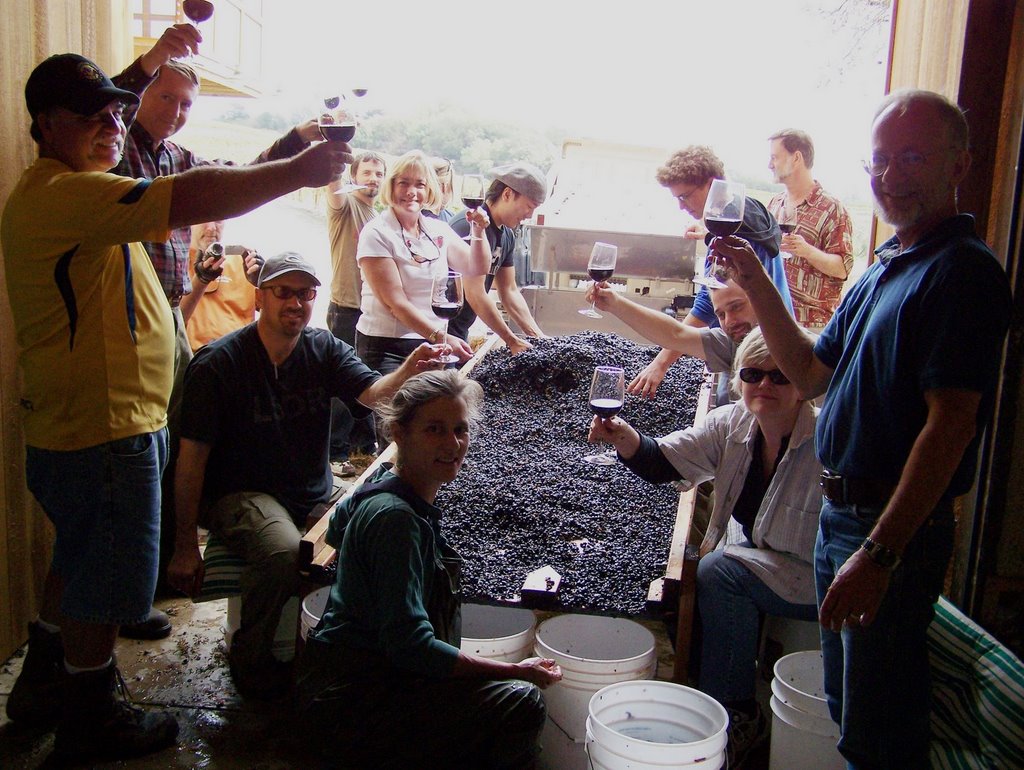
Contrary to the Realtors' concept of the best use of the cave we actually used it to make wine, lots of it with friends. Here are a few pictures to show you the alternate use of the cave. Note we had bright lights to facilitate the work and water infrastructure including hoses and a sink. Below you can see the tanks we used. In the Fall at harvest time the morning sun rises in line with the axis of the cave at its main entrance which you can see below.
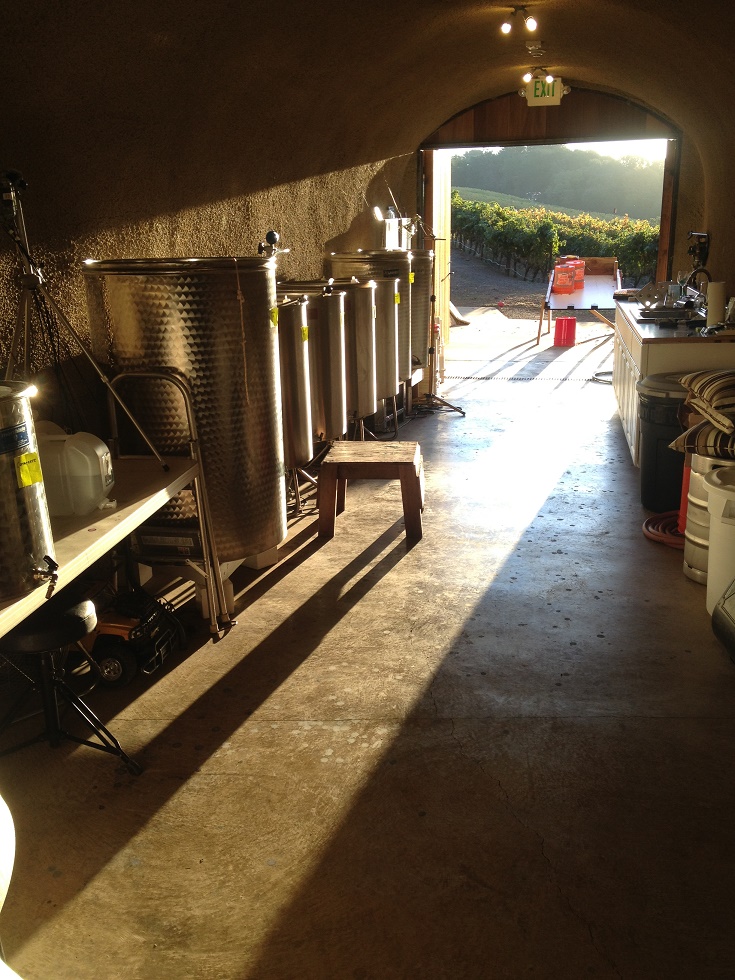
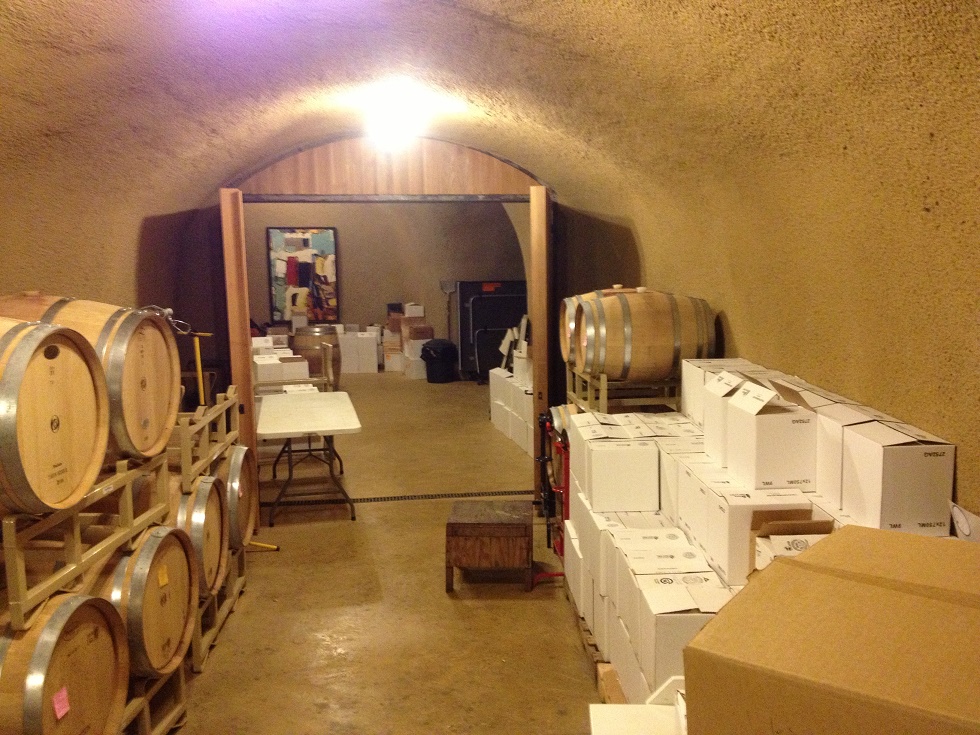
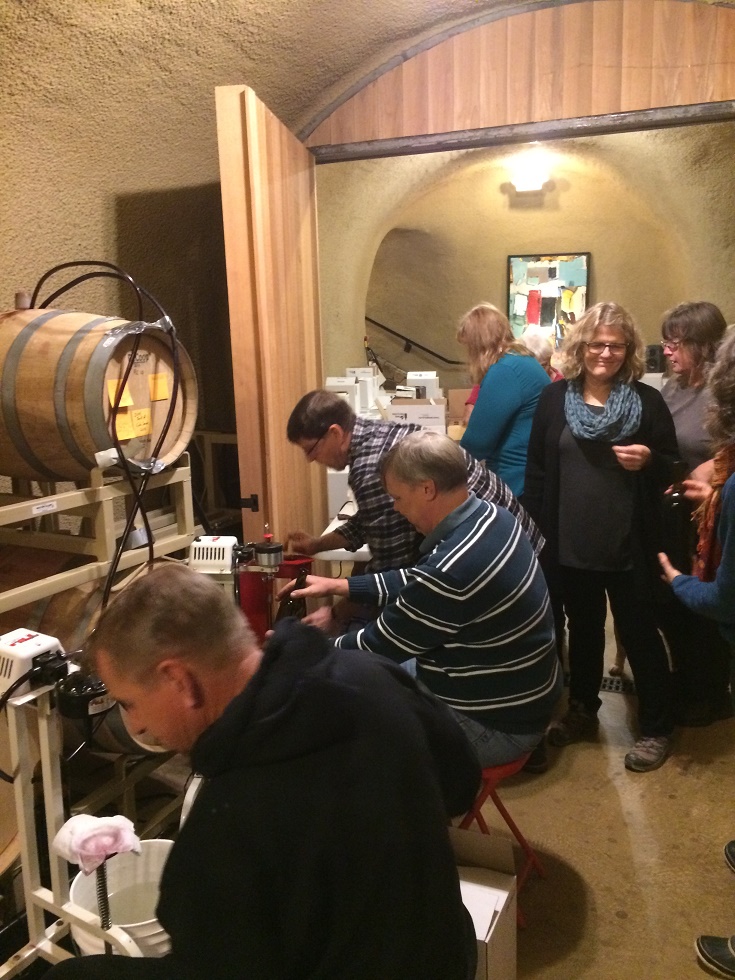
We have had many parties, Retirement, Graduation, Birthdays, Bachelorette, Harvest/Crush, Pressing, Bottling. It's truly a great place for entertaining. Type A people from the Bay Area often enjoy having something to do like making wine as part of their visit. We had a wine co-op and made wine with a dozen or so friends every year. The Cave was designed for this and supported production of about 100 cases per year. The crawler backed the full grape bins up to the cave entrance where the grapes started their journey deeper into the cave through fermentation to barrels to bottles.


The solar panels are used to heat the pool during the summer. The panels easily heat the pool 5 degrees on a sunny day. We keep the temperature around 87F. The pool is a salt pool which is replenished by rain water every winter. The water quality is great like the ambient and is a great way to get exercise.
In addition to the grapes there are a multitude of fruit trees on the site that produce some of the finest fruit you will ever taste. The temperate climate seems to enhance all the fruit that is grown there. Here is a list of the trees on site I can remember.
Bartlett Pear trees x 5, Apple trees x2 different varieties
Plum trees x10 white, red, purple. The vineyard used to be a plum orchard.
Orange, both Naval and Valencia, Grape fruit, Meyer Lemon, Mexican Lime, regular Lime
Owari mandarin orange, Peach trees, x2 early and late bearing
Pommegranate, Walnut, Quince, Cherry, Persimmon
This "garage" may look rather mundane but, it was probably my favorite part of the property. It has room for 4 cars but, it usually had a couple ATVs, a sports car and woodworking/welding shop, chain saws, wood lathe, MIG welder, 400 Amp electric service, air conditioned executive view office with web servers, electronics assembly line, electric guitar practice studio, two bathrooms and a kitchen. Being an engineer and accomplishment junkie this is where I went to create as opposed to recreate. Rain falling on the copper roof, servers warming the space, bright flourescent work lights everywhere it was a great place to be even in the depths of winter.
Soils
Mount Veeder is primarily ancient sea bottom pushed up. As a result the soils at Camalie are primarily clay. They are fine grained, relatively deep as Napa soils go and hold a lot of water. Older vines are often farmed without irrigation such as the Merlot block. See http://50.161.9.77/Soils/Soils.htm
Water
The property has a diversity of water sources mostly developed during our ownership of the property. It has 4 wells and a recorded reservoir water sharing agreement with a neighboring parcel. Water quality and volume vary from well to well but, we have found that with soil moisture monitoring and sub surface drip irrigation we consistently have adequate water for the vineyard and the house.
Well #1 Dewatering well below septic drip field, sealed off
Well #2 Dewatering well by woodpile, Limited spring output
Well #3 Used for irrigation best year 80K gal. , 30-50K gal. in more recent years
Well #4 Highest flow, 8-10 gal/min never runs dry suitable for home use but not drinking. Can be used for irrigation if diluted with water from other sources. High Sodium and boron content.
Well#5 Highest quality, potable and suitable for irrigation 0.5-3gpm. Usually enough to supply household year round. Sometimes runs dry during high demand conditions or drought years in which case well #4 is switched in to supply the house.
Well #6 Man dug well behind garage. Used for irrigation ~50K gallons/year consistently.
Strauss Reservoir, under the terms of a recorded water sharing agreement some volume up to 50% of the Strauss 2 acre ft. reservoir is available for use(325k gal.). In recent years we have received between 50k and 100k gallons. This water agreement is available for review. The neighbor owning this parcel has approached us in the last month suggesting we work together on a revision of the agreement. We pay a portion of the water system maintenance costs annually. This agreement has been operating satisfactorily for 17 years.
Note most Mount Veeder Wells draw water from modest sized basins created by land slides. As such they generally have a finite volume to provide in a given year hence the total volumes are noted above rather than flow rates which are primarily a function of pump size and initial flow rate at time of drilling which are not indicative of long term productivity.
Water meters are in place on most of the wells and are logged several times a year. This is the source of the data quoted here. Logs for the last 15 years are available.
Water analysis. Water quality is mentioned above. Detailed reports are available for wells 3,4, and 5 elsewhere.
Being a Green Home the mechanical system is a special. It uses renewable energy sources, solar and wood rather than fossil fuels. There is no propane tank on site or air conditioner using electricity. Below is a simplified schematic of the mechanical system followed by more detailed schematic and the plans for the radiant heat floors. The passive solar panels heat the house in the winter and with a couple valve changes once a year heat the pool in the summer. The masonry heater is basically a fireplace with a heat exchanger which enables it to heat the water in the thermal storage tank which is then used to heat the radiant floors. It is used to augment the heat from the solar panels. The county further required us to install a heat pump because they have yet to conceive of the possibility of an alternative to conventional heating and cooling. We have used the heat pump twice in three years primarily to check to see that it is still working. It heats water in the storage tank the same way the solar and wood sources do but uses PG&E electricity to do so.
The house depends on cool night air, and humans opening and closing windows to keep cool during the dozen or so hot days a year when the high thermal mass of the home isn't enough to keep the house cool. Windows that open and close under servo control are not readily available due to the force required. The house does have wireless/timer controlled window blinds to block morning sunlight from getting into the house and excessivly heating it. The veranda overhand protects the kitchen and first floor rooms from direct sunlight coming in most of the day. When the sun is lower in the sky in the winter the veranda lets more sunlight in to warm the house. Using the geometry of the architecture in this way which requires no cost to to sustain to manage heating and cooling of the house is key to the green philosophy.
It should be mentioned that in addition to reducing carbon emissions there are significant energy cost savings provided by this mechanical system. The passive solar system uses a small amount of electrical pumping energy to move the hot water around but, no energy to heat the water. The property has 18 acres of forest on it sequestering large volumes of carbon dioxide every day as the trees grow. The forest deadfall supplies the wood for the fireplace which puts no more carbon dioxide into the air than would the fungi that decompose the trees left on the forest floor.
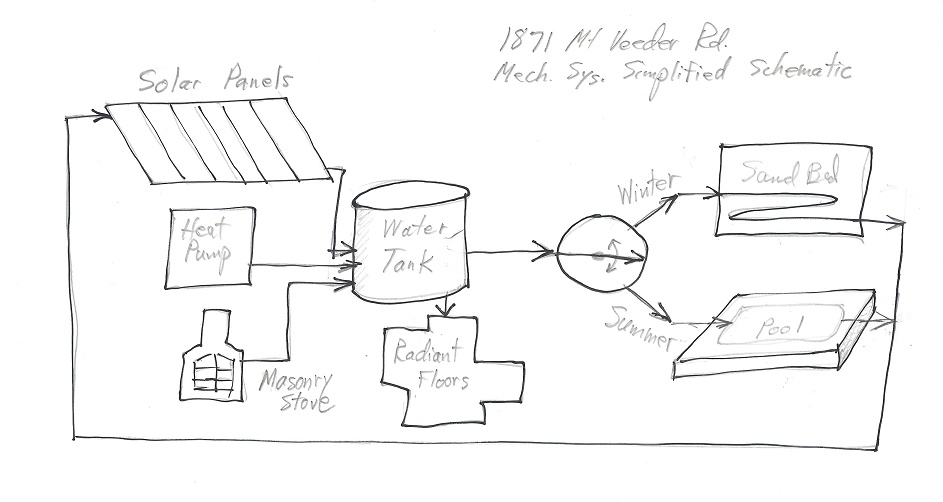
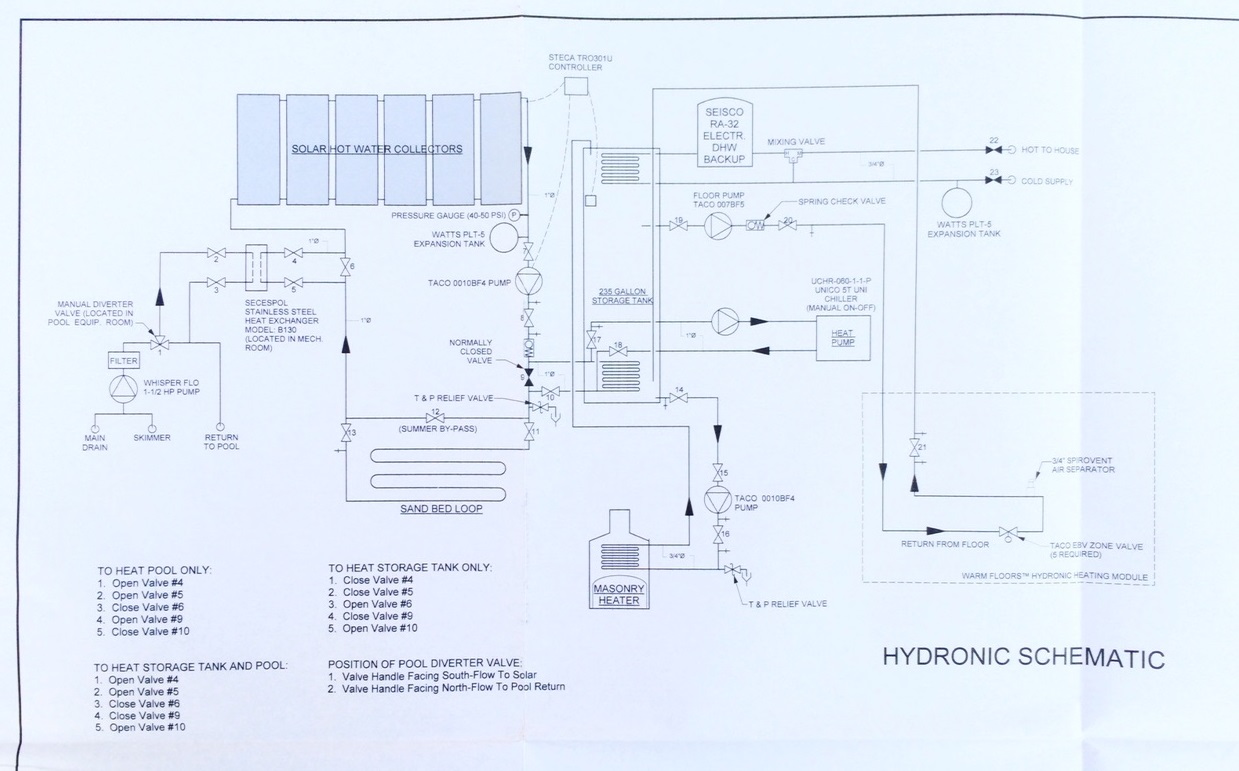
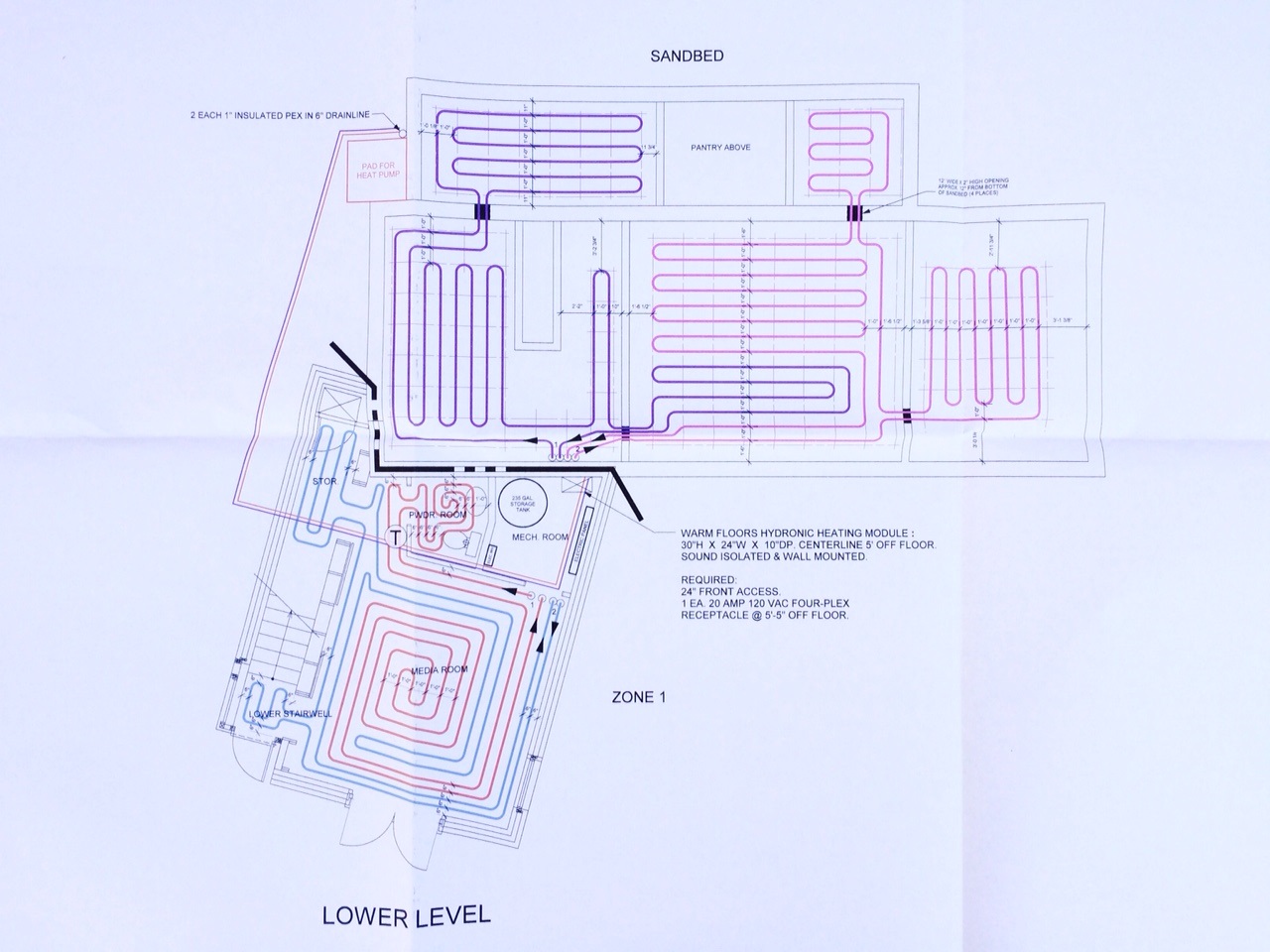
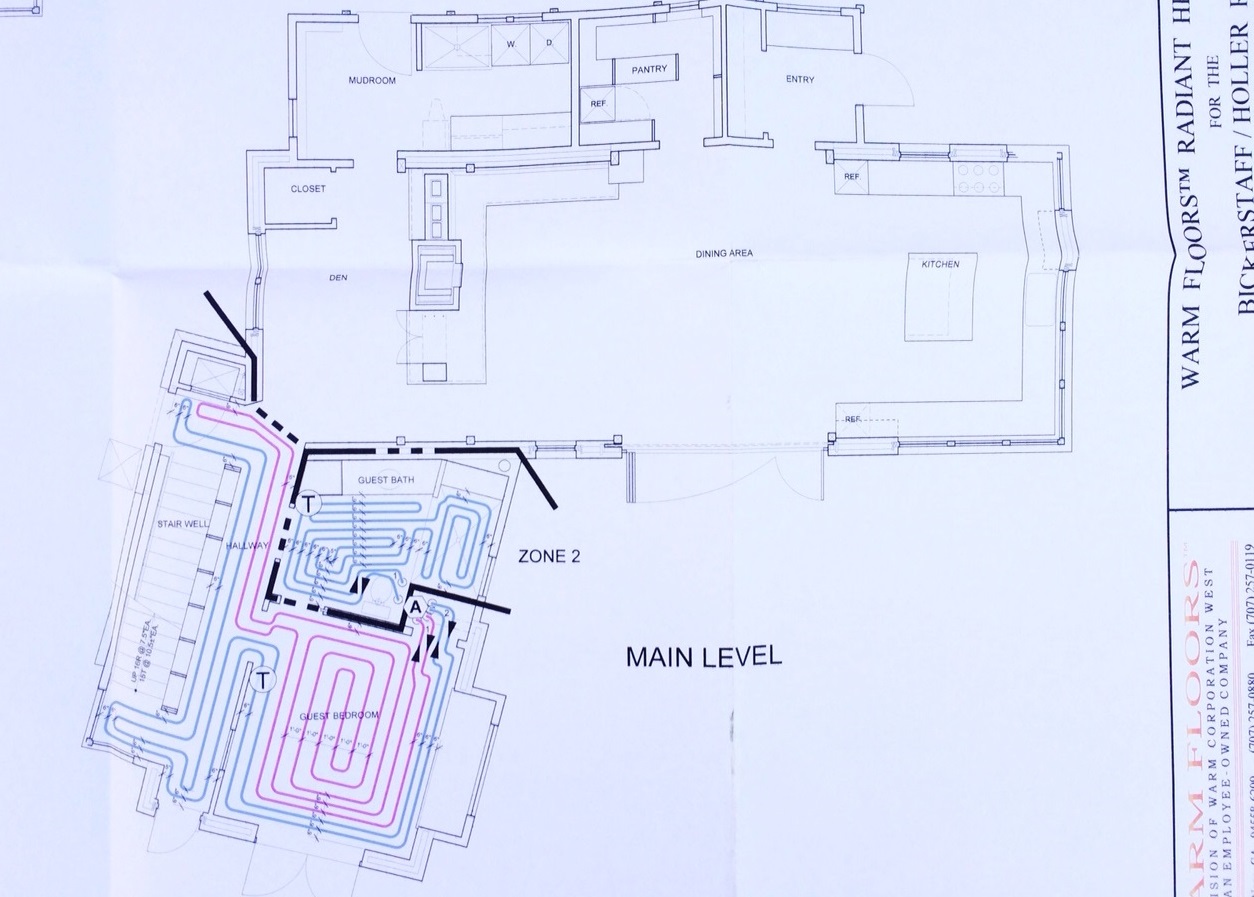
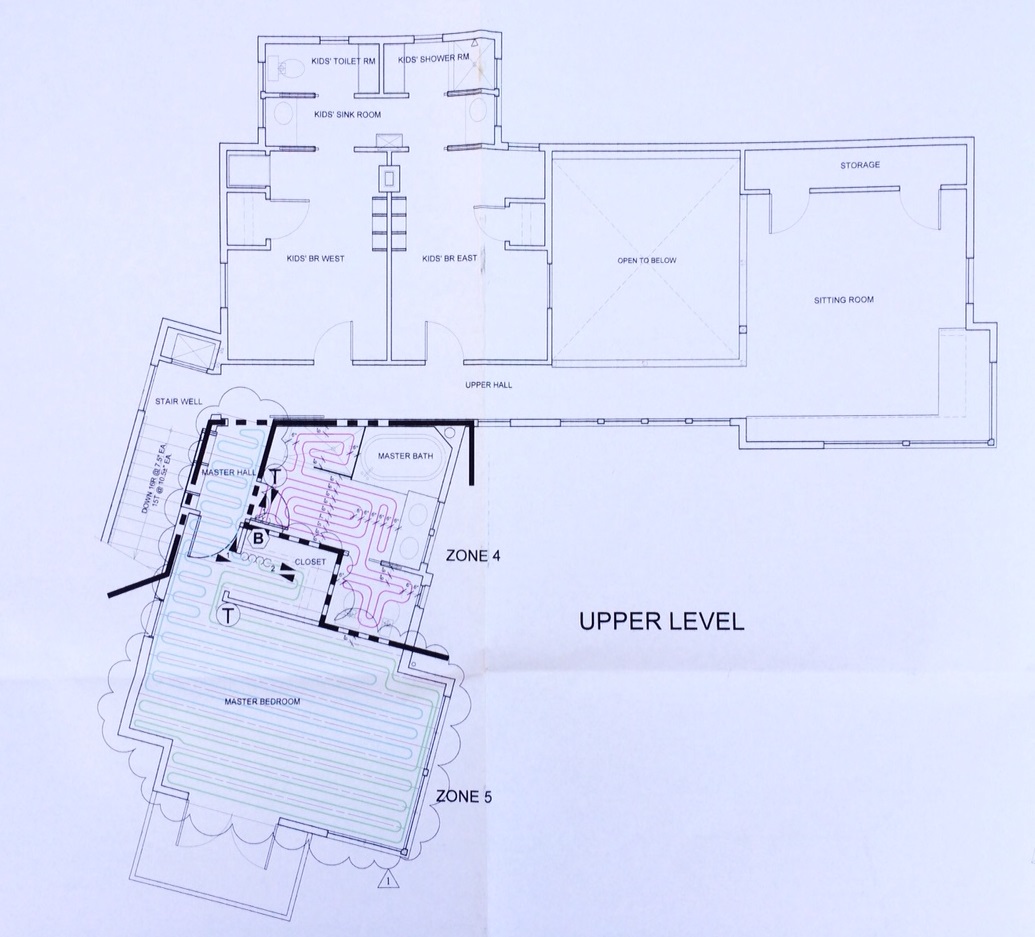
Orenco's AdvanTex Treatment System uses an engineered textile media to treat wastewater to meet stringent regulatory requirements. The filter is configured like a recirculating sand filter — a packed bed filter technology that Orenco engineers have helped to perfect since the 1970's.
AdvanTex provides consistent, reliable treatment, even under peak flow conditions. What's more, the clear, odorless effluent is ideal for reuse applications. The process reduces nitrogen significantly, and special configurations can reduce nitrogen even further to meet stringent limits.
The AdvanTex textile-based treatment technology has undergone third-party testing and evaluation to ANSI Standards. More importantly, about 17,000 residential-sized AdvanTex filters have been installed since the year 2000, and over 2,300 of our commercial-sized AX100 units are now in operation. Orenco has AdvanTex systems installed in 16 countries around the globe.
AdvanTex Treatment System comes with a program to ensure every project has support for the life of the system.
Orenco's engineers and asset management team are available to answer questions and provide ongoing manufacturer support throughout the life of your system.
The system is maintained under contract by McCollum General Engineering Contractor since it was installed. They have maintained the system and maintained our permit to operate the system with Napa County.
Photography above by Mark Holler
1871 Mount Veeder Rd. Green Home by Arkin-Tilt Architects
Photos below by the architects photographer.
Older Photos just after construction completed, 2009.
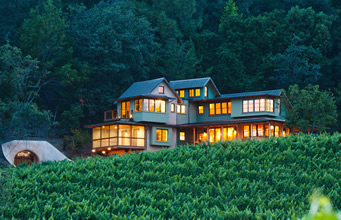
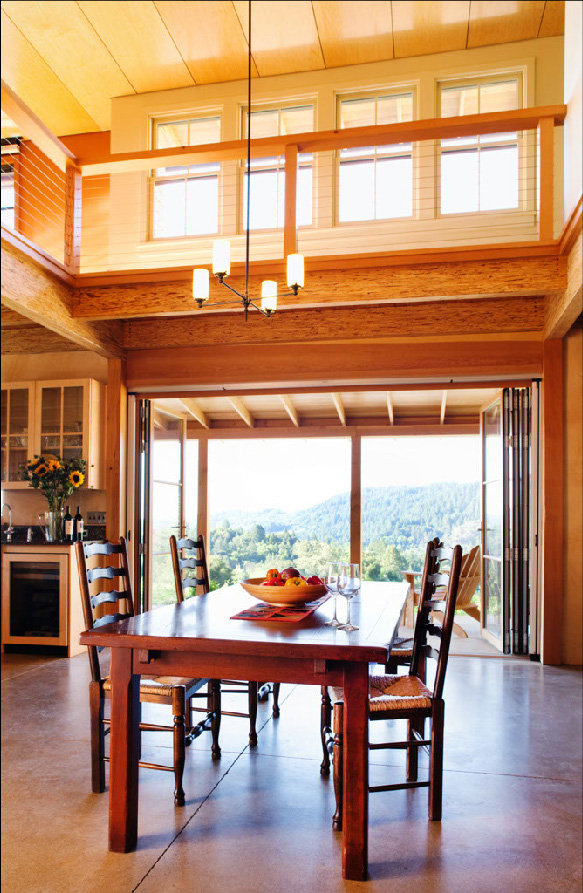
 Construction
Construction If you are interested in learning more about the property or in buying it send e-mail to mholler@pacbell.net or call 650-799-6571.
Last updated 6/28/17 M.H. Content Copyright reserved 2017 M.H.